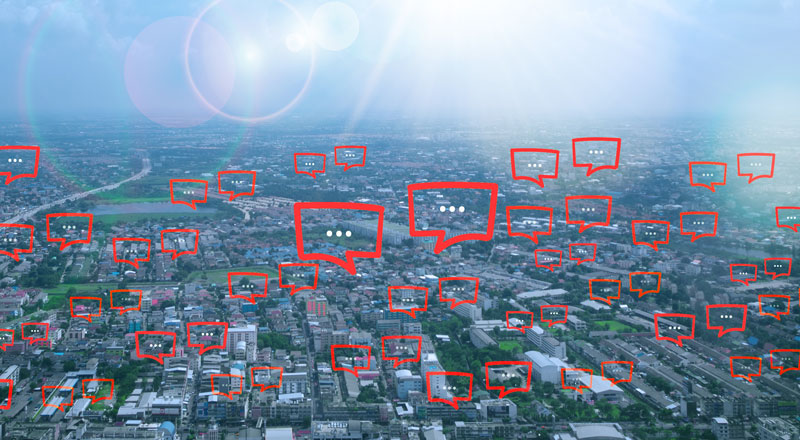In the unprecedented complexity of today’s marketing mix, with more channels and customer touchpoints than ever before, maintaining brand cohesion is a daunting task.
It wasn’t so long ago that a marketing department would only have to focus on adverts, promo materials and direct mail. Ah, simpler times! Nowadays, you can add to that social media, websites, SEO, PPC, emails and whatever else is just around the corner. The potential for inconsistency and brand damage is practically limitless.
So how are we, as marketers, supposed to find order in this chaos? Well, allow me to introduce – distributed marketing.
What is distributed marketing?
Distributed marketing, as its name suggests, is an approach that spreads the responsibility for and power of marketing across the wider business. It’s a strategy that fits a ‘distributed’ organisation – most obviously a franchise, but also any shop chain, insurance company, or indeed any organisation with a central marketing team and a network of branches, reps, agents or partners.
You can also think of it as a business-to-business-to-consumer (B2B2C) model – the central, corporate team cascades out to local teams, who themselves look after the local delivery of all marketing efforts to customers. At ROI360 we refer to this as hub and spoke model.
Examples of big companies using the distributed marketing approach include McDonald’s, Subway, Estée Lauder and Apple: businesses with exceptionally valuable brands, reliant on local teams to represent that brand and deal directly with customers.
The dangers to brand cohesion are clear. But distributed marketing is a way of reconciling the seemingly irreconcilable: tailoring marketing to the local environment without sacrificing brand consistency and control.
More flexible, more responsive, more accessible
Because market needs vary greatly from area to area, a blanket approach from corporate marketing really doesn’t cut the mustard. Cultural, economic and demographic variables all create diverse individual market demands, and to be effective the marketing message must adapt and respond to those demands. Distributed marketing makes this possible.
It also allows businesses to react much more quickly to local opportunities. Using a restaurant chain as an example, suppose there’s an event taking place near one of its premises which is certain to lead to increased footfall.
In a standard corporate marketing model, the restaurant team contacts central marketing, asks for supporting materials or assets, and then waits while they’re produced. Once they receive the materials they may then request amends. The whole process can take a length of time that the restaurant simply doesn’t have. By the time the local team have what they need, they may well have missed their chance.
Distributed marketing avoids this by giving that local team the power to create their own materials and respond to local opportunities – but within an approved framework set by central marketing. By using dynamic templates, the team can put a local twist on the corporate message and produce brand-compliant artwork in minutes.
Spreading the load of marketing across the entire organisation
The distributed marketing model makes use of specialist software that makes creating marketing materials easy. In many hub and spoke models, central marketing (the hub) might think of local teams (the spokes) as being purely sales-focused – but it doesn’t need to be that way. User-friendly software makes creating professional-looking, brand-friendly materials a cinch for anyone.
And it doesn’t mean to need completely throwing out the approval process: designs can still be checked and approved by the corporate team if desired. Crucially, that will no longer require a long chain of emails and attachments: everything can be taken care of from within the software itself.
By empowering local teams, you can expect more buy-in. More autonomy. And that means that the corporate marketing team are free to get on with the job of shaping strategy, and taking care of the bigger picture. It’s win-win.
Bringing everything under one roof
Another big strength of modern distributed marketing platforms is that they bring everything together – all those channels we talked about earlier. You can design, tweak and distribute materials for everything from direct mail to Facebook, all in one place.
That means no more working with multiple software packages and attempting to achieve consistency across diverging systems. It means flyers, emails, web banners, social posts and any other campaign materials, all under one umbrella. Marketing made simpler, easier and vastly more time-efficient.
The same applies to your entire marketing asset library. Images, logos and templates, all instantly available and quickly customisable, allowing your local teams to create professional, customised marketing materials in minutes.
With central control over the asset library, your corporate marketing team can make sure everything there is up to date and brand friendly. And when the time comes to change your logo, or even launch a full rebrand (check our rebrand post for tips on that), swapping out old assets for new couldn’t be easier.
How ROI360 makes life simpler for everyone
That’s distributed marketing at a glance, but ROI360’s software offers a lot more besides. Here’s a quick summary:
- Built-in analytics let you see who’s doing what, control who has access to what, and pick up on possible pain points
- Budget control tools allow you to closely monitor resources and your local teams to keep track of their spend
- Flexible approval process means you can have as much or as little control over the sign-off procedure as you like – and vary it from user to user
- Consolidate everything from print orders to merchandise purchases within a single, easy-to-use system
Explore distributed marketing software for yourself
ROI360 is designed to support a distributed marketing approach that strikes the perfect balance between central control and local autonomy. To find out how else it can deliver smarter ways of working, set up a free demo account and have a look around. No trial, and no credit card required. Just an easy way to see how it works.
If you’re unsure whether your organisational model would benefit from distributed marketing software, you can also quickly obtain your Suitability Score by answering a few simple questions.
Bottom line: if you work for a distributed organisation, distributed marketing could transform your business. Explore our website, demo our software and check your suitability score to get a better idea of the difference it could make.




